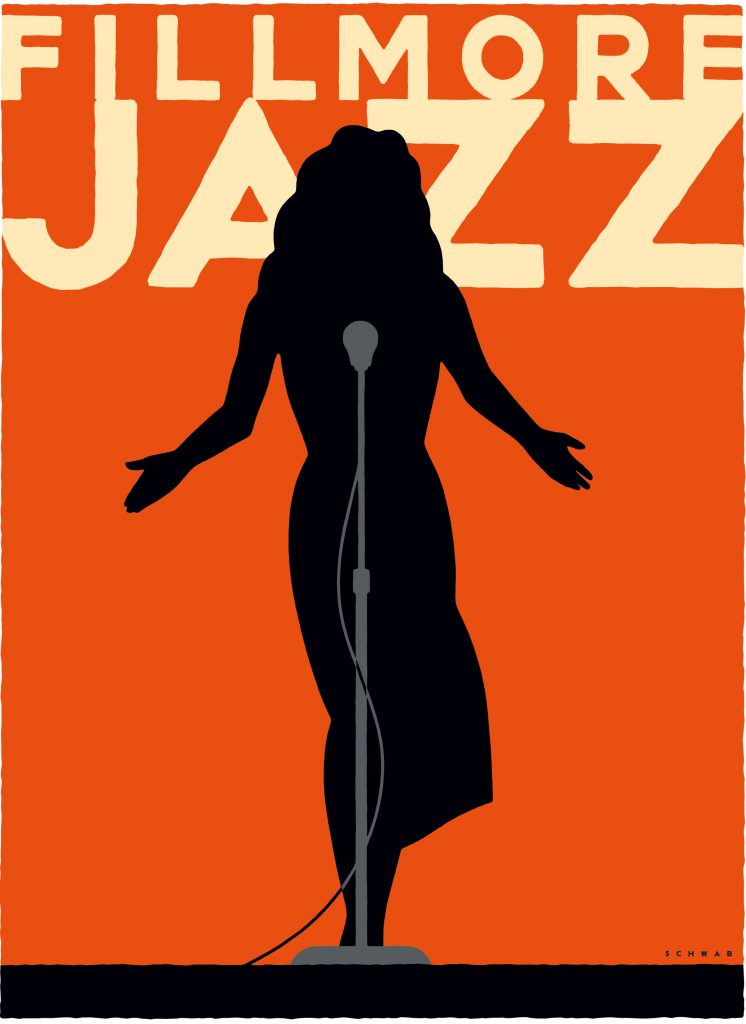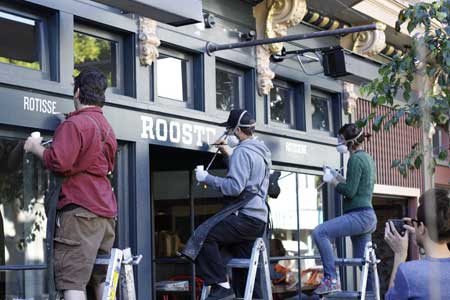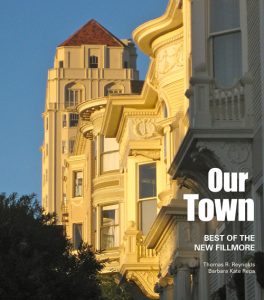DESIGN | Chris Barnett
San Francisco graphic designer Christopher Simmons has a long list of powerhouse clients including Facebook, Microsoft, Wells Fargo Bank, Stanford, Kaiser Permanente and the Nature Conservancy. So why in an uncertain economy would he take a flyer on two Fillmore startups that sell Vietnamese sandwiches and rotisserie chickens?
For Simmons, owner of the design firm MINE, it was a matter of pride — and guilt.
“I got an e-mail from Denise Tran, who was planning to open Bun Mee, a small restaurant specializing in casual yet upscale Vietnamese street food, but I didn’t respond for six or seven days,” Simmons admits. When he did call, Tran told him she had decided to go with a New York City creative house.
Simmons, a soft-spoken 39-year-old who favors vintage tennis shoes and wears only scruffy duds made before 1970, says he “always wanted to do a restaurant.” He had a good feeling about Tran and her concept and offered to do a full-blown proposal anyway in two days.
Tran recalls it somewhat differently. “I had committed to the other firm, but Christopher called and persuaded me to reconsider. His pitch was so much stronger that I hired him instead.”
After five years in practice as a corporate attorney in Seattle, Tran wanted to escape the billable hours and do something enjoyable. Two years of on-the-road research convinced her that an informal eatery built around a gourmet version of the humble banh mi sandwich (pronounced “bun mee”), plus other traditional and modern Vietnamese dishes, mostly based on her mother’s home recipes, was her ticket out.
She was right. Bun Mee opened in April 2011 at 2015 Fillmore for lunch and dinner. A year later, lines of clamoring customers often spill down the sidewalk.
But before the success hit, Tran was dealing with two design consultancies to get a single seamless visual theme. Simmons’ laundry list of visual suggestions and clever touches, assembled in just two days, brought the concept to life.
For starters, Simmons and MINE staff designer Nathan Sharp went to the legendary Saigon Sandwiches in the Tenderloin to sample their first banh mi sandwich. It was a far cry from Tran’s Hanoi crispy catfish sandwich or the sloppy bun packed with ground beef infused with red curry, a spicy spin on the classic sloppy joe. Next, Simmons tackled a project that had long given Tran fits: a Bun Mee logo that would double as the restaurant’s exterior sign.
“I had actually been working on a logo with another local design firm and it took me three months to get up the courage to tell them their concept wasn’t going to work because I hated it so much,” recalls Tran. “I thought it was my fault because I had never worked with a design firm before and I’m a very, very picky person. It was like something was lost in translation and I was frustrated.”
 Simmons started a new logo from scratch. The French influence in Vietnamese cuisine got him thinking that Bun Mee could have the soul of a simple early 20th century brasserie in a sleek 21st century setting.
Simmons started a new logo from scratch. The French influence in Vietnamese cuisine got him thinking that Bun Mee could have the soul of a simple early 20th century brasserie in a sleek 21st century setting.
To make sure that message didn’t get lost, Simmons suggested handpainting the restaurant’s name over the front door in sizeable but not overwhelming red block capital letters with a thin white inline accent color. Underneath the name would be an equally simple description of what’s inside: a “Vietnamese sandwich eatery.”
As expected, Tran was tough to please. “It took three solid months of different versions — back and forth — to get the logo right,” says Simmons. “But I remember getting an e-mail from Denise on Christmas Eve telling me how happy she was, for the first time, that she had a visual of what Bun Mee was going to look like.”
The designer also felt that the artisanal handpainting of the signs helped reinforce the concept that all Bun Mee sandwiches — indeed, everything on the menu, from Mekong shrimp salads to Saigon peanut rice bowls — would be handmade. Even the menu was handpainted on pieces of wood and hung on the wall; each dish has its own small board. If the chefs add a new item or cancel an old one, the menu can be easily changed.
Other design details inside are refreshingly restrained. Photographs capturing swarms of Vietnamese street food hawkers populate the walls. And since there are likely as many Vespas in the Southeast Asian country as in Italy, Simmons used discreet ads for the ubiquitous motor scooter as wall art as well. A warming MINE touch: a slab of rusted corrugated metal that covers the surface underneath the cash register. Another eye-grabber is a suspended shelf filled with motor oil cans that have the red logo on the label and are filled with Bun Mee T-shirts. Proceeds from shirt sales go to charity.
Tran is currently looking for the next Bun Mee location and is sticking with the identity she’s already bought and paid for. “Any business owner who wants to save money by not spending it on branding or graphic design today is making a big mistake,” she says.
[nggallery id=21]
The ideas Simmons and Sharp developed for Bun Mee have been effective advertising for the MINE design office.
“Restaurants are a hard industry to crack, but once you’re in, you’re in,” Simmons says. A case in point: Chefs Gerard Darian and his wife Tracy Green checked out Tran’s eat-in or take-out hotspot and hired mine to help Roostertail, described as their “new, hip, fast casual American rotisserie,” take flight in the neighborhood.
Darian had worked the stoves at Wolfgang Puck’s famed Spago in West Hollywood during the 80s, was sous chef at Puck’s Postrio here in San Francisco in the 90s — where he met Green, who was also working in the kitchen — and was later executive chef at Bix on Gold Alley in the design district. Then the couple owned a sandwich shop for 10 years, but became restless and wanted to try out a new culinary concept. Their choice: fresh rotisserie cooked chicken at moderate prices — $5.75 for a quarter of a chicken to $18.50 for a whole bird — along with a few other “lean protein” main dishes, “substantial sides” and hefty sandwiches.
It took them a year to find a prime, affordable location. They eventually landed the space at 1963 Sutter, just off Fillmore, the longtime location of Cafe Kati.
“We liked what was happening in the lower Fillmore, the 1,800-foot space had good bones and we decided to just go for it,” Darian says. With local architect, space planner and interior designer Stacy Jed, they also created a self-serve eatery, but theirs has twice the seating space of Bun Mee.
 Roostertail also needed a distinctive logo that would be memorable and could double as an outside sign. Envisioning a lively array of customers of all ages, Simmons started with the universal symbol of romance — a plump heart pierced by an angel’s arrow — and morphed it into a big-breasted chicken speared by a rotisserie spit. “We were going for the classic Americana feel in the food,” says Darian. “We were a quick, casual order place with an upscale twist.”
Roostertail also needed a distinctive logo that would be memorable and could double as an outside sign. Envisioning a lively array of customers of all ages, Simmons started with the universal symbol of romance — a plump heart pierced by an angel’s arrow — and morphed it into a big-breasted chicken speared by a rotisserie spit. “We were going for the classic Americana feel in the food,” says Darian. “We were a quick, casual order place with an upscale twist.”
Roostertail opened last December and has been packing in the crowds ever since. Jed, the architect and interior designer, went for nostalgia. Some of the walls have light gray wainscoting; others have iconic subway tiles. Big vats of lemonade and a bundt cake under glass, made according to Tracy Green’s mom’s recipe, gently harken back to simpler times. Simmons extended that theme with typography and handpainted signage.
Although the place bills itself as a “fast-casual” eatery, the look and feel encourage diners to relax, and 20 distinctive beers plus wine and root beer are offered to help them do just that. The open kitchen, with a collection of hanging pots and pans overhead, is further testimony that Roostertail is no kin to the colonel. With the exception of French fries, there’s nothing fried on the menu. And speaking of menus, Simmons outdid himself here: Every dish has its description on a magnetic tile for simple daily updating.
Roostertail has also added a new twist on food to go. Call ahead, pay with a credit card and a “takeout concierge” will dash out and hand off your meal, saving the hassle of finding a parking space.
[nggallery id=22]
EARLIER: “Scooter street food on Fillmore”
Filed under: Art & Design, Food, Drink & Lodging





